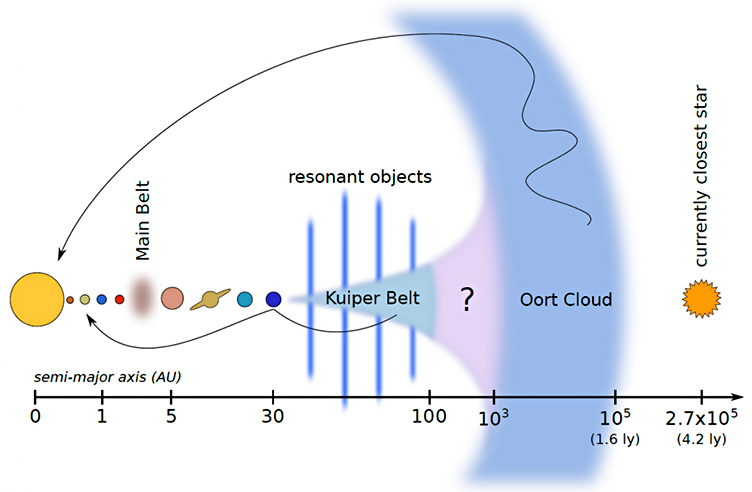Comets and Trans-Neptunian Objects (TNOs)

Transneptunian objects (TNOs)
We have developed a secular model for orbital dynamics of transneptunian objects in mean motion resonance with a planet (typically Neptune). This model reveals trajectories leading to very distant orbits (perihelion beyond 80 au), as well as “capture mechanisms”, able to keep objects in very distant orbits for billions of years. The application to known remote objects graphically shows if the orbit requires a complex scenario, such as planetary migration or an outside perturbator, or if it can be explained by the influence of giant planets on their current orbits. In particular, we bring confirmation that the two objects with the most distant perihelia known (Sedna and 2012VP113, 76 and 80 au) can not be explained by the influence of the known objects of the Solar System. Three articles on these topics (Saillenfest et al. 2016, Saillenfest et al. 2017a, Saillenfest & Lari 2017) are worth mentioning.
We were also interested in the secular dynamics of transneptunian objects disturbed by a hypothetical distant planet. A semi-analytical model with two degrees of freedom can be obtained and studied by sections of Poincaré. For increasing semi-major axes, chaos is spreading very rapidly around liberation islands due to the Kozai mechanism. The most persistent structures are secular resonances producing aligned or anti-aligned trajectories with the distant planet. An article on the subject (Saillenfest et al. 2017B) is worth mentioning.
Oort Cloud
A study of the long-term evolution of an Oort cloud initially flattened on the ecliptic and the long-lived comet flux obtained after a 4.5 Ga evolution of the proto-cloud (Fouchard et al., 2017a) was conducted. It has been shown that the shape of the Oort cloud rapidly reaches a state of equilibrium with two components: an inner component that remains flattened on the ecliptic and an outer component carved by the galactic tides. The transition between these two components depends on the evolution time. It is found to be between 1 500 and 2 000 au after 4.5 Ga. It has been shown that a majority of observable comets were in the Jupiter and Saturn region during their previous perihelion passage (i.e., an orbital period before observability). The comparison with observations (Fouchard et al. 2017b) shows that this result is consistent, as well as the proportion of observable/observed comets found in retrograde orbits versus their semi-major axis: this proportion is slightly greater than the average for comets with a semi-major axis less than 25 000 au while there is practically an equal distribution between prograde and retrograde for comets with larger semi-major axes.
Last update Friday 19 June 2020